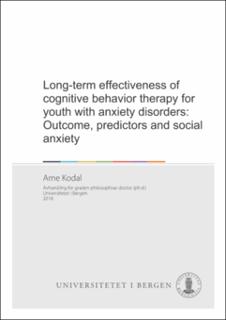| dc.contributor.author | Kodal, Arne | en_US |
| dc.date.accessioned | 2018-09-10T12:13:12Z | |
| dc.date.available | 2018-09-10T12:13:12Z | |
| dc.date.issued | 2018-06-01 | |
| dc.identifier.isbn | 978-82-308-3753-5 | en_US |
| dc.identifier.uri | https://hdl.handle.net/1956/18450 | |
| dc.description.abstract | Cognitive behavioral therapy (CBT) has demonstrated favorable long-term outcomes in youth with anxiety disorders in efficacy trials. However, long-term outcomes of CBT delivered in a community setting are uncertain. The aim of study presented in this thesis was to examine the long-term effectiveness of CBT for youth with mixed anxiety disorders treated in community mental health clinics. In addition, potential predictors of long-term outcomes were assessed, and subtypes of social anxiety disorder were investigated. The thesis consists of three papers presenting findings of this study. Data stem from a randomized controlled trial examining the effectiveness of CBT for youth with anxiety disorders treated in seven participating community mental health clinics in Western Norway. A total of 139 youth (mean age at assessment 15.5 years, range 11– 21 years) with a principal diagnosis of separation anxiety disorder (SAD), social anxiety disorder (SOP), and/or generalized anxiety disorder (GAD) were evaluated, on average, 3.9 years post-treatment (range 2.2–5.9 years). Long-term outcome was defined as loss of all inclusion anxiety disorders, loss of the principal inclusion anxiety diagnosis, and changes in youth- and parent-rated youth anxiety and depressive symptoms. Paper I examined the long-term outcomes of individual (ICBT) and group CBT (GCBT) using multilevel modeling and equivalence testing. Paper II assessed predictors of long-term outcomes using multilevel modeling. Paper III investigated pre-treatment subtypes of SOP in youth with the disorder drawn from the original sample, using exploratory factor analyses. In Paper I, results demonstrated loss of all inclusion anxiety disorders in 53% of participants, loss of the principal anxiety diagnosis in 63%, as well as significant reductions in all youth- and parent-rated youth anxiety and depression symptom measures at long-term follow-up. No significant differences in outcome were identified between ICBT and GCBT, and equivalency was partially established. Significant symptom reductions were found between pre-treatment and long-term follow-up, although participants with a principal diagnosis of SOP had lower odds for recovery, compared to those with a principal diagnosis of SAD or GAD. In Paper II, the study identified low family social class as the most stable predictor of poorer outcomes. High treatment motivation was associated with better outcomes, whereas a diagnosis of SOP was associated with worse outcomes, including when analyses were controlled for other predictors. Recovery from the principal anxiety disorder at post-treatment was associated with better outcomes at long-term follow-up. In Paper III, the study identified three distinct subtypes of SOP, labelled performance, observation, and interaction. Exploratory factor analyses of avoidance responses showed these were best represented by one avoidance factor. Few youth qualified exclusively for any of the fear subtypes, thus calling into question the clinical utility of these subtypes. Nevertheless, the findings indicate distinct contributions of fear and avoidance in SOP presentation. In conclusion, the findings support the long-term effectiveness of ICBT and GCBT for youth with mixed anxiety disorders treated in community clinics. Few pretreatment predictors were associated with long-term outcomes, although low family social class and a diagnosis of SOP were associated with poorer outcomes. High treatment motivation was associated with better outcomes. Subtypes of SOP were identifiable and differed from avoidance-based subtypes. The clinical implications of the findings are that CBT treatment for youth anxiety can be disseminated to community clinics and delivered in both individual and group formats, providing improvement rates almost on par with those in efficacy studies. Careful assessment at pre-treatment may help to identify youth who need augmented or more specific treatment, i.e., youth with SOP. It is questionable if subtypes of SOP are of clinical utility, although targeting of specific fear domains may enhance treatment. | en_US |
| dc.language.iso | eng | eng |
| dc.publisher | The University of Bergen | eng |
| dc.relation.haspart | Paper I: Kodal, A., Fjermestad, K., Bjelland, I., Gjestad, R., Öst L. G., Bjaastad, J. F., Haugland, B. S. M., Havik, O. E., Heiervang, E. R., &., Wergeland, G. J., (2018). Long-term effectiveness of cognitive behavioral therapy for youth with anxiety disorders. Journal of Anxiety Disorders, 53, 58-67. The article is available at: <a href="http://hdl.handle.net/1956/18449" target="blank">http://hdl.handle.net/1956/18449</a> | en_US |
| dc.relation.haspart | Paper II: Kodal, A., Fjermestad, K., Bjelland, I., Gjestad, R., Öst L. G., Bjaastad, J. F., Haugland, B. S. M., Havik, O. E., Heiervang, E. R., &., Wergeland, G. J. Predictors of long-term effectiveness of cognitive behavioral therapy for youth with anxiety disorders. Full text not available in BORA | en_US |
| dc.relation.haspart | Paper III: Kodal, A., Bjelland, I., Gjestad, R., Wergeland, G. J., Havik, O. E., Heiervang, E. R., & Fjermestad, K. (2017). Subtyping social anxiety in youth. Journal of Anxiety Disorders, 49, 40-47. The article is available at: <a href="http://hdl.handle.net/1956/18448" target="blank">http://hdl.handle.net/1956/18448</a> | en_US |
| dc.title | Long-term effectiveness of cognitive behavior therapy for youth with anxiety disorders: Outcome, predictors and social anxiety | en_US |
| dc.type | Doctoral thesis | |
| dc.rights.holder | Copyright the Author. All rights reserved | |
| dc.identifier.cristin | 1586772 | |
